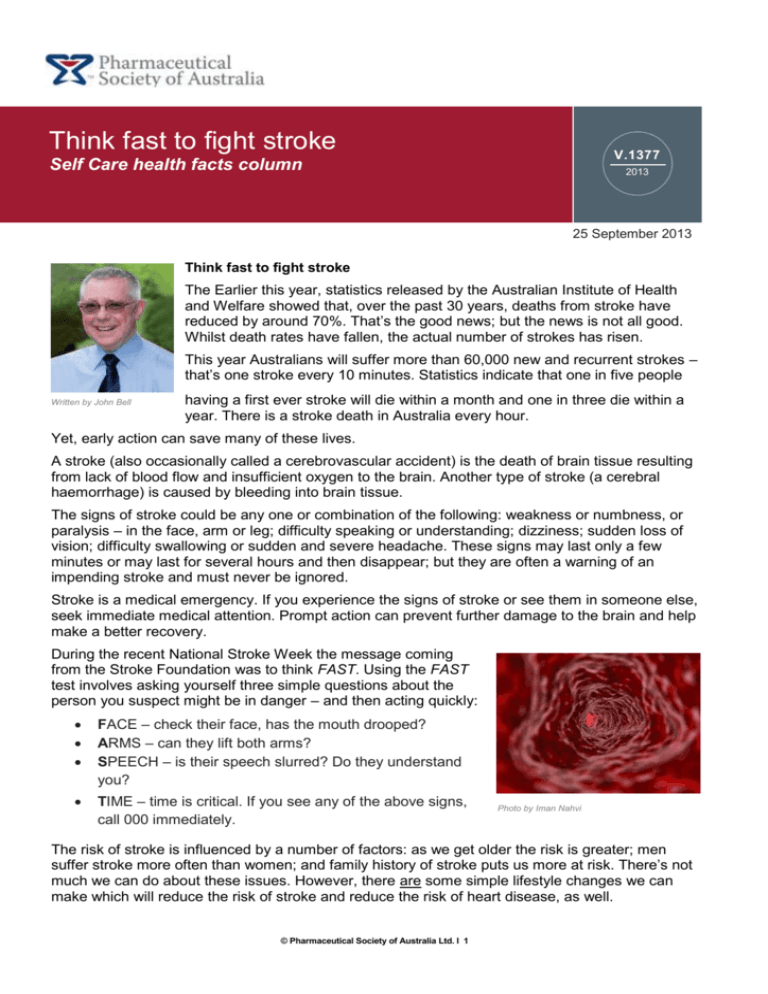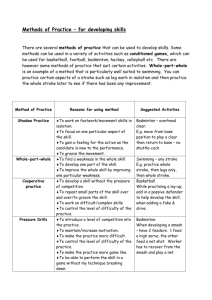1377 Think fast to fight stroke - Pharmaceutical Society of Australia
advertisement

Think fast to fight stroke V.1377 Self Care health facts column 2013 25 September 2013 Think fast to fight stroke The Earlier this year, statistics released by the Australian Institute of Health and Welfare showed that, over the past 30 years, deaths from stroke have reduced by around 70%. That’s the good news; but the news is not all good. Whilst death rates have fallen, the actual number of strokes has risen. This year Australians will suffer more than 60,000 new and recurrent strokes – that’s one stroke every 10 minutes. Statistics indicate that one in five people Written by John Bell having a first ever stroke will die within a month and one in three die within a year. There is a stroke death in Australia every hour. Yet, early action can save many of these lives. A stroke (also occasionally called a cerebrovascular accident) is the death of brain tissue resulting from lack of blood flow and insufficient oxygen to the brain. Another type of stroke (a cerebral haemorrhage) is caused by bleeding into brain tissue. The signs of stroke could be any one or combination of the following: weakness or numbness, or paralysis – in the face, arm or leg; difficulty speaking or understanding; dizziness; sudden loss of vision; difficulty swallowing or sudden and severe headache. These signs may last only a few minutes or may last for several hours and then disappear; but they are often a warning of an impending stroke and must never be ignored. Stroke is a medical emergency. If you experience the signs of stroke or see them in someone else, seek immediate medical attention. Prompt action can prevent further damage to the brain and help make a better recovery. During the recent National Stroke Week the message coming from the Stroke Foundation was to think FAST. Using the FAST test involves asking yourself three simple questions about the person you suspect might be in danger – and then acting quickly: FACE – check their face, has the mouth drooped? ARMS – can they lift both arms? SPEECH – is their speech slurred? Do they understand you? TIME – time is critical. If you see any of the above signs, call 000 immediately. Photo by Iman Nahvi The risk of stroke is influenced by a number of factors: as we get older the risk is greater; men suffer stroke more often than women; and family history of stroke puts us more at risk. There’s not much we can do about these issues. However, there are some simple lifestyle changes we can make which will reduce the risk of stroke and reduce the risk of heart disease, as well. © Pharmaceutical Society of Australia Ltd. I 1 High blood pressure and high blood cholesterol levels are a major contributing factor to blood vessel disease which often leads to stroke. Blood pressure and cholesterol levels can be managed; sometimes just by sensible attention to diet and exercise; and sometimes by the regular, and usually long term, use of medicines. If you do need medicines to lower your blood pressure, the possibility is that they will need to be taken forever. Sometimes that is difficult to accept; especially when, in all likelihood, there are no noticeable symptoms of the blood pressure being raised. In fact, occasionally the medicines themselves have unwanted effects. They may make you feel drowsy, dizzy or nauseated. If side effects with your blood pressure medicines do occur, you should tell your doctor and pharmacist. There are several other factors, too, which make stroke more likely – smoking, being overweight, having uncontrolled diabetes or having an irregular pulse (known as atrial fibrillation or AF). For more advice about treating and preventing stroke, call into one of the 2,000 pharmacies around Australia providing the Pharmaceutical Society’s (PSA) Self Care health information. For the nearest location phone 1300 369 772 or visit www.psa.org.au and click on “Self Care” then “Find a Self Care Pharmacy”. © Pharmaceutical Society of Australia Ltd. I 2







